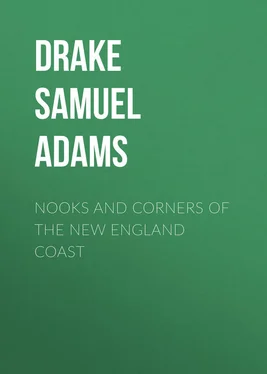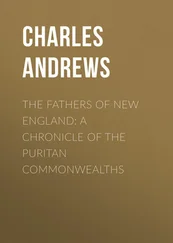Samuel Drake - Nooks and Corners of the New England Coast
Здесь есть возможность читать онлайн «Samuel Drake - Nooks and Corners of the New England Coast» — ознакомительный отрывок электронной книги совершенно бесплатно, а после прочтения отрывка купить полную версию. В некоторых случаях можно слушать аудио, скачать через торрент в формате fb2 и присутствует краткое содержание. Жанр: foreign_antique, foreign_prose, на английском языке. Описание произведения, (предисловие) а так же отзывы посетителей доступны на портале библиотеки ЛибКат.
- Название:Nooks and Corners of the New England Coast
- Автор:
- Жанр:
- Год:неизвестен
- ISBN:нет данных
- Рейтинг книги:3 / 5. Голосов: 1
-
Избранное:Добавить в избранное
- Отзывы:
-
Ваша оценка:
- 60
- 1
- 2
- 3
- 4
- 5
Nooks and Corners of the New England Coast: краткое содержание, описание и аннотация
Предлагаем к чтению аннотацию, описание, краткое содержание или предисловие (зависит от того, что написал сам автор книги «Nooks and Corners of the New England Coast»). Если вы не нашли необходимую информацию о книге — напишите в комментариях, мы постараемся отыскать её.
Nooks and Corners of the New England Coast — читать онлайн ознакомительный отрывок
Ниже представлен текст книги, разбитый по страницам. Система сохранения места последней прочитанной страницы, позволяет с удобством читать онлайн бесплатно книгу «Nooks and Corners of the New England Coast», без необходимости каждый раз заново искать на чём Вы остановились. Поставьте закладку, и сможете в любой момент перейти на страницу, на которой закончили чтение.
Интервал:
Закладка:
In the confusion naturally incident to accounts of early discoveries on our coast of New England, it is pleasant to find one vantage-ground from which you can not be dislodged. In this respect Pemaquid stands almost alone. It has never been called by any other name. Possibly it may have embraced either more or less of the surrounding territory or adjacent waters than at present; still there is eminent satisfaction in standing at Pemaquid on impregnable ground.
In the minds of some old writers Pemaquid was unquestionably confounded with the Penobscot. There is a description of Pemaquid River from the Hakluyt papers, 46 46 "Purchas," vol. iv., 1874.
which makes it the easternmost river, one excepted, of Mavoshen, manifestly a name erroneously applied, as the description is as far from coinciding with the true Pemaquid as is its location by Hakluyt. In this account the Sagadahoc and town of Kennebec are also mentioned. Like many others, it is more curious than instructive.
It also appears, to the student's dismay, that in some instances the discoverers were apprehensive of drawing attention to any new-found port or harbor, as it would render their monopoly of less value. The account of Weymouth's voyage by James Rosier omitted the latitude, doubtless with this object. His narrative, if not written to mislead, was confessedly not intended to instruct. How is the historian to follow such a clue? Fortunately, after many puzzling and unsatisfactory conjectures, the account of William Strachey makes all clear, so far as Pemaquid is in question. Weymouth's first landfall was in 42°, and he coasted northward to 44°. Strachey speaks of "the isles and rivers, together with that little one of Pemaquid."
Sir F. Gorges, in his "Brief Narration," mentions that "it pleased God" to bring Captain Weymouth, on his return in 1605, into the harbor of Plymouth, where he, Sir Ferdinando, then commanded. 47 47 In 1603 Gorges was deprived of the command, but had it restored to him the same year.
Captain Weymouth, he continues, had been dispatched by the Lord Arundel of Wardour in search of the North-west Passage, but falling short of his course, had happened into a river on the coast of America called Pemaquid. In the reprint of Sir F. Gorges's invaluable narrative 48 48 "Collections of the Massachusetts Historical Society," vol. vi., 3d series.
the word Penobscot is placed after Pemaquid in brackets. It does not appear in the original.
Pemaquid, then, becomes one of the pivotal points of New England discovery, as it subsequently was of her history. As the French had directed their early efforts toward the Penobscot, so the English had imbibed strong predilections for the Sagadahoc, or Kennebec. Weymouth and Pring had paved the way; the Indians transported to England had been able to give an intelligible account of the country, the configuration of the coasts, the magnitude of the rivers, and power of the nations peopling the banks.
The Kennebec was known to the French earlier than to the English, and by its proper name. Champlain's voyage in the autumn of 1604 extended, it is believed, as far as Monhegan, as he names an isle ten leagues from " Quinebequi " and says he went three or four leagues beyond it. Moreover, he had coasted both shores of the Penobscot bay, penetrating at least as far as the Narrows, below Bucksport. He calls the Camden hills Bedabedec, and says the Kennebec and Penobscot Indians were at enmity. De Monts followed Champlain in June, 1605, having sailed from St. Croix two days after Weymouth's departure from the coast for England. He was more than two months in exploring a hundred and twenty leagues of sea-coast, visiting and observing the Kennebec, of which a straightforward story is told. Even then the river was known as a thoroughfare to Canada. 49 49 See Lescarbot, p. 497.
The mouth of the Kennebec is interesting as the scene of the third attempt to obtain a foothold on New England's soil. This was the colony of Chief-justice Popham, which arrived off Monhegan in August, 1607. 50 50 Strachey. Gorges says August 8th; Smith, August 11th.
This undertaking was intended to be permanent. There were two well-provided ships, and a hundred and twenty colonists. 51 51 A fly-boat, the Gift of God , George Popham; Mary and John , of London, Raleigh Gilbert.
The leader of the enterprise, George Popham, was accompanied by Captain Raleigh Gilbert, nephew and namesake of Sir Walter Raleigh.
A settlement was effected on Hunnewell's Point, at the mouth of the Kennebec. The winter was one of unexampled severity, and the new-comers had been late in preparing for it. Encountering privations similar to those afterward endured by the Plymouth settlers, they lost courage, and when news of the death of their patron, the chief-justice, reached them, were ready to abandon the project. Popham, having died in February, was succeeded by Gilbert, whose affairs recalling him to England, the whole colony deserted their settlement at Fort St. George in the spring of 1608. Popham was the first English magistrate in New England.
Mather attributes the failure of attempts to colonize the parts of New England north of Plymouth to their being founded upon the advancement of worldly interests. "A constant series of disasters has confounded them," avers the witch-hating old divine. One minister, he says, was exhorting the eastern settlers to be more religious, putting the case to them much in this way, when a voice from the congregation cried out, "Sir, you are mistaken; you think you are preaching to the people of the Bay. Our main end was to catch fish."
"Did you ever see Cotton Mather's 'History of New England?' – one of the oddest books I ever perused, but deeply interesting." The question is put by Southey, and I repeat it, as, if you have not read Mather's "Magnalia Christi Americana," you have not seen the corner-stone of New England historical and ecclesiastical literature.
Apropos of the immigration into New England, it was openly bruited in England that King Charles I. would have been glad if the thousands who went over were drowned in the sea. Between the years 1628 and 1635 the exodus was very great, and gave the king much displeasure. No one was permitted to remove without the royal permission. Even young Harry Vane had to solicit the good offices of his father, Sir Harry, to obtain a pass. He was then out of favor at court and at home, through his Geneva notions about kneeling to receive the Sacrament, and other Puritan ideas. "Let him go," growls an old writer; "has not Sir Harry other sons but him?"
The colony of Popham began better than it ended. A fort, doubtless no more than a palisade with platforms for guns, was marked out. A trench was dug about it, and twelve pieces of ordnance were mounted. Within its protection fifty houses, besides a church and store-house, were built. The carpenters framed a "prytty pynnace" of thirty tons, which they christened the Virginia . There is no earlier record of ship-building in Maine.
The tenacity of the English character has become proverbial. Nevertheless, the opinion is hazarded that no nation so ill accommodates itself to a new country. The English colonies of Virginia, New England, and Jamaica are striking examples of barrenness of resource when confronted with unforeseen privations. The Frenchman, on the contrary, possesses in an eminent degree the capacity to adapt himself to strange scenes and unaccustomed modes of life. Every thing is made to contribute to his wants. Let the reader consult, if he will, the campaign of the Crimea, where thousands of English soldiers gave way to hardships unknown in the French camps. The elastic gayety of the one is in contrast with the gloomy despondency of the other. The Popham colony abandoned a well-matured, ably-seconded design through dread of a New England winter and through homesickness. Clearly it was not of the stuff to found a State.
Читать дальшеИнтервал:
Закладка:
Похожие книги на «Nooks and Corners of the New England Coast»
Представляем Вашему вниманию похожие книги на «Nooks and Corners of the New England Coast» списком для выбора. Мы отобрали схожую по названию и смыслу литературу в надежде предоставить читателям больше вариантов отыскать новые, интересные, ещё непрочитанные произведения.
Обсуждение, отзывы о книге «Nooks and Corners of the New England Coast» и просто собственные мнения читателей. Оставьте ваши комментарии, напишите, что Вы думаете о произведении, его смысле или главных героях. Укажите что конкретно понравилось, а что нет, и почему Вы так считаете.












